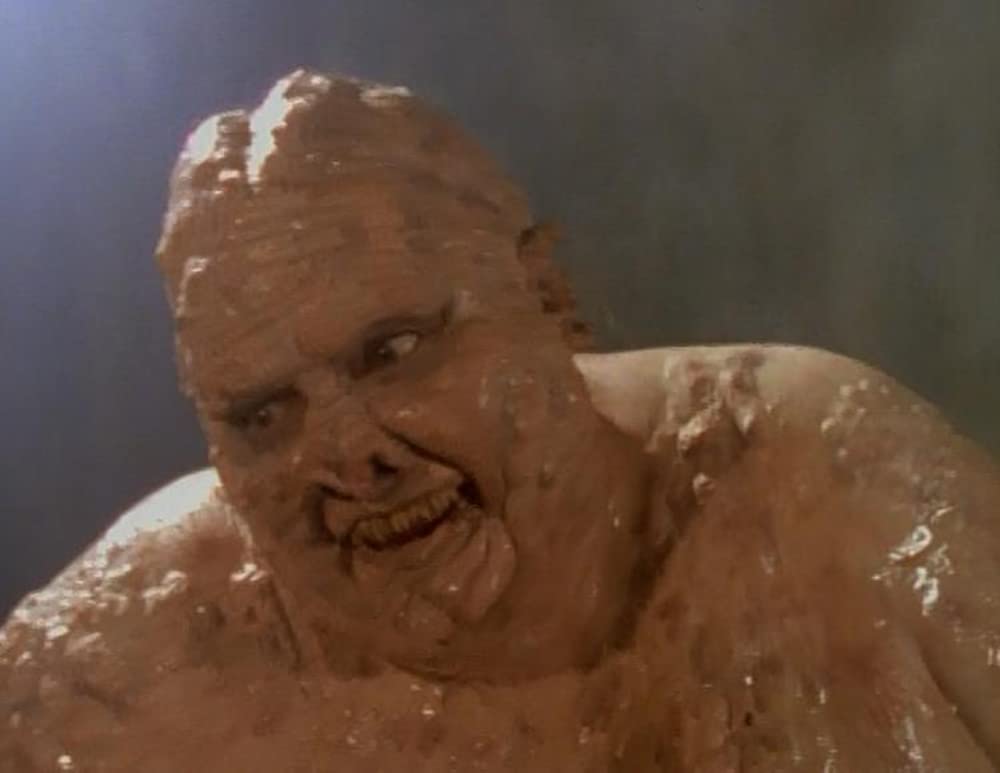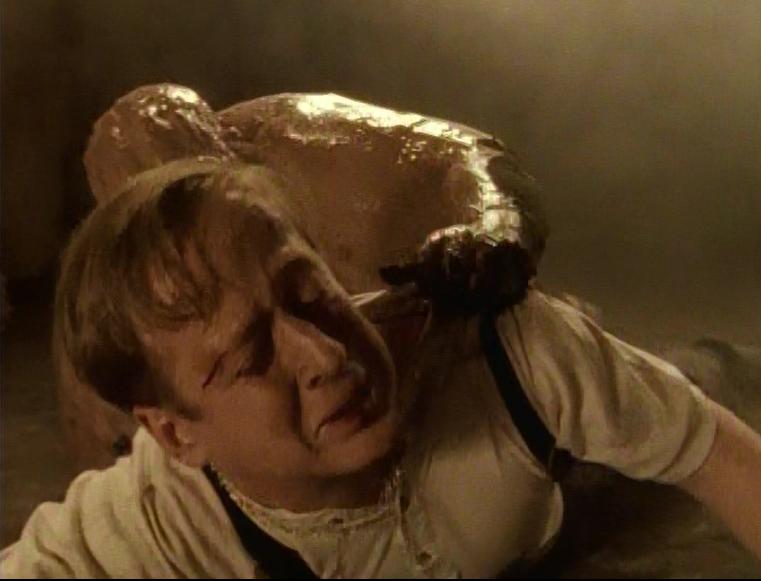The Feverman, a Monsters episode, is odd, even if it is a bit of a made-up story. The story takes place in the past and follows a wealthy physician and a man who has a sick daughter. The wild card is that a well-known local healer has arrived in town, claiming to be able to perform the healing trick despite the affluent doctor’s doubts.
This is a heartbreaking story because it highlights the expense of drugs. The episode is dramatic, with twists and turns, but it is most notable for Dick Smith’s makeup as the monster, which, in my opinion, looks horrifying. McCallum has one of the best performances of the entire series as the boozed-up old-timer.
Monsters; THE FEVERMAN, Tales from the Paulside

The series begins with The Feverman, a grim tale about a healer who, in exchange for a large sum of money, heals incurable people for whom medicine has failed, but at a much greater price. The series is incredibly low-budget, yet this episode is fantastic despite the constraints imposed by a lack of funds. The idea is intriguing, the plot is well-written and has a powerful message, and the characterization is exceptional for a twenty-minute film.
The episode does have a disturbing gloomy mood, and the setting is modest but powerful. It’s a straightforward tale. Timothy Mason is in a dire situation since his daughter has a potentially deadly fever for which no doctor has a treatment. He searches for the Feverman, a relatively close figure who can heal any fever for a hefty fee and has lived for hundreds of years.
Dr. James Burke pursues them, unable to give treatment but outraged by the idea of a distressed father resorting to what he deems quackery to save his dying daughter. I mean, isn’t it possible that someone will consider the sentiments of genuine doctors? What an inconsiderate person. As you could expect, the Feverman is keen to help, but Burke has to interfere and completely destroys everything.
Going ahead in the story, Mr. Mason, a distressed family man in the Victorian Period, sends his ailing daughter to an unconventional healer known as “The Feverman” against the protests of his regular physician, Dr. Burke, in “The Feverman,” the first episode of Monsters. Burke’s fears about Feverman, Mr. Boyle, appear justified at first, given that he is a cranky, ill-mannered drunkard.
When Mr. Burke interrupts Boyle’s ritual to heal the Mason girl, he is taken aback to discover the truth: The Feverman fights each ailment he comes across in lethal, physical warfare, and the girl’s fever manifests as a blubbery, metastatic tumor monster in this case.
When Burke’s intervention results in Boyle’s death, the Feverman orders the conventional physician to take his place and murder him.
The central theme of the first tale is the deeply established belief in our culture that only Medical science can “cure” the ill, and that anything other or from any other system is quackery.
Dr. Burke, for example, is dismissive and skeptical about Boyle’s method to cure the ill in The Feverman, even calling him a trickster. He is concerned because Mason is being duped. He also inquires about Boyle’s willingness to return Mason’s money if he dies.
Burke sometimes refunds his money when his patients die, he asks. Boyle’s retort is spot on. It’s implied that they’re both physicians, but their approaches are different. In some ways, this appears to become a subliminal acknowledgment of the East/West dichotomy regarding how things are done. When Burke realizes this, the story achieves its pinnacle, and he is confronted by a horrific and unforgettable monster, the first one in the series’ stable.
In this scenario, the Mason girl’s fever is shown as a gigantic, meaty obese creature, “large and strong,” and understands how to “attack, but not defend,” as Boyle puts it. The key to eliminating it is to go all-in, which Boyle does in the end. He wrestles the monstrous, tumor-covered illness to the ground, snapping its neck. Doctors wage fight with their patients’ ailments daily, but it’s amusing how this Monsters episode depicts that battle as a real-life, physical contest, in which the doctor has just as much blood in the game as his patient.
Indeed, The Feverman is, in some ways, all about Burke and how he goes from being set on his ways, committed to tradition and routine, to ultimately breaking free to save a life.
The Feverman is a set-in-his-ways doctor who opens his mind to new ideas, new therapeutic routes, and a new way of looking at the world.
WHY YOU SHOULD WATCH IT

A skeptic tries to show his frantic buddy with a sick kid that the local famed healer he wants to meet is a con artist.
A father sends his ill daughter to the “Feverman,” a man famed for physically ‘fighting’ sickness or fever to treat the sick. The local doctor, on the other hand, objects. The sum the Feverman demands from the man is far less than the price the Feverman must pay himself, and when the doctor intervenes, he discovers the true cost of a life.
The variety of guest performers and actresses that paraded through the show’s dinky small sets every week was, in hindsight, the most intriguing aspect of the show. Future talents like Steve Buscemi, Matt LeBlanc, and Rob Morrow mingled alongside veteran actors like Linda Blair, Pam Grier, and Wil Wheaton.
It’s always amusing to see a recognizable face out of context. Joey Tribbiani debating with Wesley Crusher about how the eerie old barbershop is actually a vampire sanctuary is a nice laugh. Frank Gorshin, Darren McFadden, David Spade, and Jerry Stiller are among the other famous guest stars. This anthology series has no recurring characters because each 21-minute installment is self-contained.
Based on the show’s opening sequence, the first episode, a macabre spin of all-American families settling down in the front of the boob tube, just in early for their favorite show, should be cheesier. The Feverman appears to be an exception in the sequence, but this isn’t the case as we’ll see later. It’s only that the tone is solemn, with no attempt at humor. Everything is performed in its entirety, from the discourse to the impending threat.
It’s risky to start the series with a historical narrative, but the Victorian setting instantly provides an atmosphere. The sepia color scheme conjures up memories of a bygone era with antiquated attitudes and customs. The mythos about faith healers battling disease’s bodily manifestations is a fabrication.
Fevermen may be made up, but quackery isn’t. While fighting the devil that is causing the child’s illness, the feverman clashes with a contemporary doctor (Patrick Garner), who naturally doubts his tactics. Of course, it was simpler to persuade someone that their illness was caused by evil rather than infections back then.
The episodes are short, clocking in at around 22 minutes each, making it simple to get caught up on the collection. They’re on a very even keel in terms of plot, with a few exceptions. They frequently include some really well-executed special effects and make-up that one would not anticipate from such mass-produced, non-serialized material. They may not be on par with HBO’s Tales from the Crypt series from the same period, but I’m sure they weren’t made on the same budget.
Monsters are an underappreciated asset that many people have forgotten about. This re-release of the entire series is a great way to reconnect with an old friend while also introducing it to a younger generation who may have missed it when it first aired.
AMAZING AUDIO AND VIDEO QUALITY

Monsters were developed for television and shot long before widescreen was popular, therefore it’s offered here in its original 4X3/1.33:1 aspect ratio. The image has been washed and cleaned, however, it is not hi-def owing to its age and authentic quality. There is some pixelation and streaks, but it isn’t intrusive or enough to take away from the overall fun. Those of us who remember the show’s first season will feel right at home, while newbies will be alright but will have to settle for a lower-quality transfer.
The audio is equally limited by time and technological limitations. The Dolby Digital 2.0 output sounds great, but it’s not the same as current outputs.
